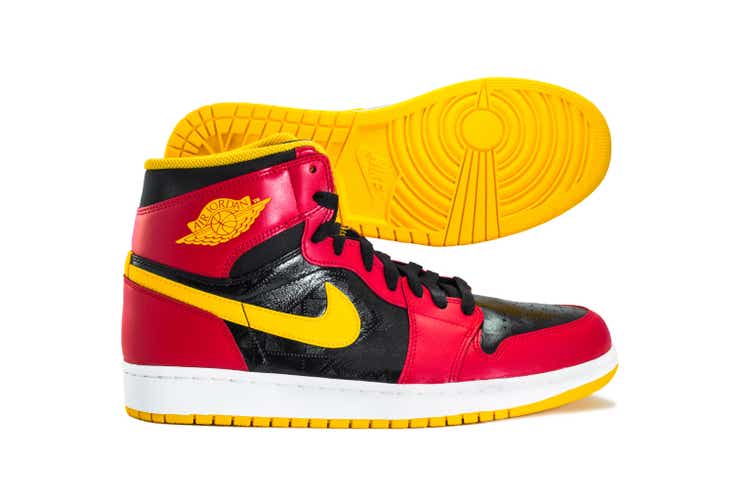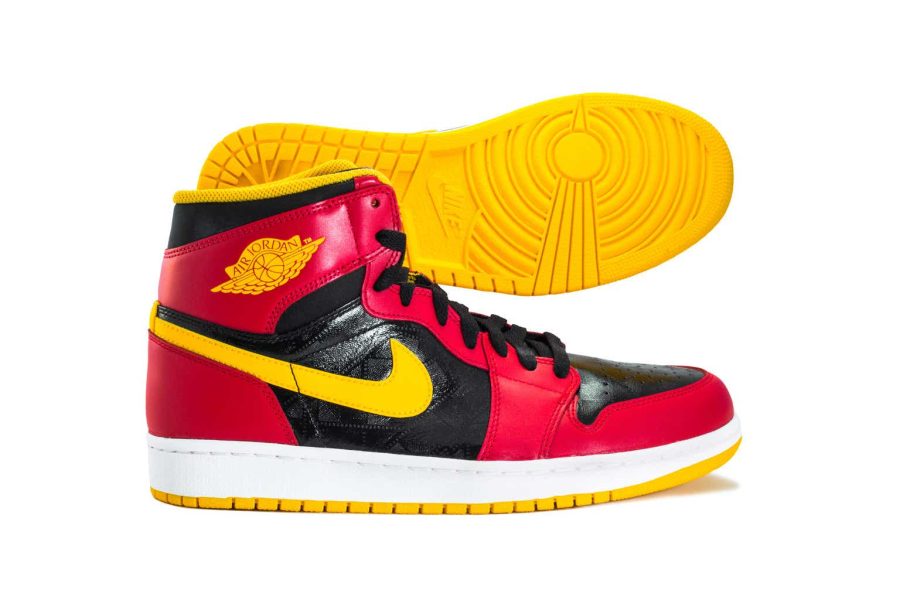Summary:
- Nike shares have dropped significantly since 2021 due to a shift to online sales and increased competition, but college endorsements offer a path to recovery.
- NIL deals with college athletes and pros can rejuvenate Nike’s brand, similar to the impact of Michael Jordan’s endorsement in the 1980s.
- While Nike’s turnaround will take time, strong long-term profitability metrics and growth potential in China suggest a buy rating.
- Despite risks, early signs indicate that the brand endorsement strategy is working, offering unique upside for investors.
littleny
Co-Authored By Noah Cox and Brock Heilig
Investment Thesis
Nike (NYSE:NKE)(NEOE:NKE:CA) shares are down roughly 55% from their all-time high in late 2021, closing at $80.90/share as of the time of this writing.
Over the last few years, Nike has made a series of missteps that have caused sales to slow and for the US-based shoe giant to lose its shine. This slide started when the shoemaker increased their efforts toward online sales and directing consumers to the Nike mobile app rather than selling through more traditional methods like in-person stores. Since most shoes are bought in person (you try them on) this was a big miss in my opinion and built more on a temporary change in trends during COVID vs. a more durable change in consumer habits.
Because of this decision, and as the pandemic waned, other athletic footwear companies inserted their products onto the shelves that Nike left vacant, and competitors began to gain exposure. With this, Nike has slid down the consumer preference list. They are losing their luster to up-and-coming competitors like On and Hoka, who have acquired valuable shelf space and gotten the attention of consumers.
Nike has to implement a new strategy to bounce back from this dropoff, and I think college deals are the answer.
Numerous D1 universities here in the US are signed with Nike, including some of the nation’s biggest football brands like the University of Michigan, the University of Alabama and the University of Texas.
A college-play comes at the right time. With the legalization of Name, Image and Likeness (NIL) licensing in college sports, athletes are now able to sign with companies like Nike, which benefits both parties.
Over the last few years, Nike has signed some of the biggest names in college athletics to endorsement deals. Shedeur Sanders (Colorado), Caitlin Clark (Iowa, now WNBA) and Bronny James (USC) are all Nike-sponsored athletes. These athletes are all likely to go on and have famous careers. They’ll be wearing Nike shoes and gear when they do it.
If Nike can continue on this path, I think they’ll be in a good spot to succeed. Sanders, Clark and James are just three of the many uber-popular athletes Nike has signed with in the last 3 years since NIL became legal. Hunting for deals with universities and their athletes is the path to success for Nike going forward.
While Nike has a long way to go, and shares clearly reflect the company is still in the middle of a turnaround, I think they are a buy.
How Did We Get Here
Nike, formerly known as Blue Ribbon Sports, was founded by Bill Bowerman and Phil Knight in 1964. Knight graduated from the University of Oregon — which is unironically a Nike-sponsored school — where he teamed up with Bowerman to launch Nike.
Over the first 55 years of the company’s history, Nike has been seen as the go-to brand for shoes and athletic wear. It established itself early as arguably the most recognizable brand in sports.
Unfortunately, over the last few years, as Nike has shifted its focus to online sales through its website, other smaller competitors have been able to crack their way into the industry and compete with Nike. Consumers have grown a liking for newer options, and now Nike is fighting to get its audience back.
Not only are shares down significantly since the peak in 2021, but growth overseas in places like China is coming in far below the rate of their competitors. As noted by Seeking Alpha from an article earlier this week, companies like Deckers Brands (DECK) and On (ONON) have seen sales increase drastically in the Asia-Pacific region. While both are starting from a lower denominator (smaller base revenue) it’s clear their growth is eating away at Nike’s customer base.
For On, Q2 sales increased 73.7% in the Asia-Pacific region. Meanwhile, Deckers Brands reported “meaningful” Q1 growth in China.
What NIL Deals Can Do For Nike
For Nike, they need to be seen as a shoe brand and athletic company that’s in a league of their own. Right now, consumers are not viewing Nike this way when it comes to their shoe lineup.
Historically, brand sponsorship deals were the bedrock of Nike and made the company into who they are today.
When star basketball player Michael Jordan signed a deal with Nike back in 1984, it changed the landscape of the shoe industry. As Jordan’s popularity grew throughout the late 1980s and early 1990s, the Nike brand, in turn, grew as well. Jordan put Nike on the map.
Jordan was arguably one of the most famous athletes on the planet in his prime, and his deal with Nike got the shoe company plenty of exposure as millions of eyes were on the star player. Jordan changed the game for Nike. New NIL deals can do the same thing again.
While we’re still in the early infancy stage of brands seeing the benefits of NIL, Nike is coming to the realization that signing big-time athletes (while they are still smaller in College) can allow their shoes or clothing to be on the football field or on the basketball court. This is an opportunity to keep their name out there as being worn by the future greats of every industry.
Nike needs this. They need to be, once again, compared to no other shoe in the market.
This is one area in which Nike can squeeze its competitors out. Brands like On and HOKA have not yet broken into the athlete endorsement industry yet in any way near the way Nike has. Nike has an opportunity to lock this up.
Why Brand Deals Matter Now More Than Ever
Let’s be clear: brand deals have been around for decades. It’s not like this (in and of itself) is a new strategy. What matters is how Nike is executing this.
While Nike pulling back physical merchandise space is a setback, Nike is recognizing that much of the buying decision (viewing the product, building an affinity with the product, etc) is not done online. Americans (and more groups of people for that matter) spend more time than ever on their phones and facing a screen. Nike is increasing their time in-front of consumers through content and athlete endorsements. It’s working.
In 2023, Nike signed a five-year deal with USA Women’s Gymnastics ahead of the 2024 summer Olympics in Paris. The USA Women’s Gymnastics team wore Nike apparel throughout the games. When Simone Biles won the team its third gold medal of the games on July 31st, visits to Nike’s website peaked at 2 million, with 86,900 of those visits resulting in a sale.
Beyond the qualitative metrics, Wall Street is getting bullish as well. Analyst Michael Binetti recently noted:
Based on our extensive channel work, we think Nike has started to take many of the early steps necessary to execute a turnaround (albeit a complex turnaround that will take a long time to actualize, for sure).
Valuation
To emphasize, Nike is not on track to rebound quickly in the next 12 months (this is going to take awhile). The consensus EPS Growth Rate for the fiscal year ending May 2025 is -20.97%.
After FY 2025, however, things start to turn around. The EPS estimate from here (year ending May 2026) comes in at 15.22% growth. In the fiscal year ending May 2027 it’ll be 11.92% YoY growth, and growth will stabilize from here at 14.14% YoY growth.
What I am getting at is while EPS growth this year is set for a dropoff, this isn’t forever. This is part of the company making necessary changes in order to make their business lean.
Their one-year forward estimated P/E is 25.85 times forward earnings. I actually think this seems a little low given the strong profitability metrics over the long run and good return on equity over the last 12 months (the company has a return on common equity of 40.09% which is insane).
Nike is a good brand in the midst of a tough turnaround. I think Nike should realistically be trading at 30 times earnings to account for the growth in China and the possibility for Nike to once again make their shoes in a league of their own.
If we saw their PE increase from 25.85 to roughly 30, it would represent roughly 16% upside.
Risks
For Nike to nail this turnaround, their shoes (and athleticwear) really have to be seen in a league of their own by consumers. The big risk that comes from this is that just as Nike sees the right signals that consumers are picking up their shoes and clothes again, consumer weakness means that many choose to go with the lower priced shoe options as the economy slows. Higher shoes especially are a discretionary good for consumers. They won’t buy them if the economy is doing poorly.
Thankfully, this week’s retail numbers were strong enough to abate concerns. Retail sales that were recently released show that U.S. consumers are still spending strongly.
Retail sales were up 0.1% month over month in August, compared to the expectation of a 0.2% decline month over month.
Bottom Line
Since the end of COVID and the strategy change on their store-stocking strategy, Nike has let smaller competitors gain ground in the shoe market industry. It hurt earnings and caused shares to fall off. Nike needs a turnaround plan. College endorsements are at the heart of it.
Nike still has a good grip on the college endorsement market with both colleges and athletes, and that’s where I think the future of the company is at.
While the company is not clear, there is strong early evidence that the brand endorsements strategy from up-and-coming athletes is making a big difference. Shares should start to reflect this as sales pick back up.
Shares are higher risk from here but offer a unique upside. I think they’re a buy.
Analyst’s Disclosure: I/we have no stock, option or similar derivative position in any of the companies mentioned, and no plans to initiate any such positions within the next 72 hours. I wrote this article myself, and it expresses my own opinions. I am not receiving compensation for it (other than from Seeking Alpha). I have no business relationship with any company whose stock is mentioned in this article.
Noah Cox (main account author) is the managing partner of Noah’s Arc Capital Management. His views in this article are not necessarily reflective of the firms. Nothing contained in this note is intended as investment advice. It is solely for informational purposes. Invest at your own risk.
Seeking Alpha’s Disclosure: Past performance is no guarantee of future results. No recommendation or advice is being given as to whether any investment is suitable for a particular investor. Any views or opinions expressed above may not reflect those of Seeking Alpha as a whole. Seeking Alpha is not a licensed securities dealer, broker or US investment adviser or investment bank. Our analysts are third party authors that include both professional investors and individual investors who may not be licensed or certified by any institute or regulatory body.
